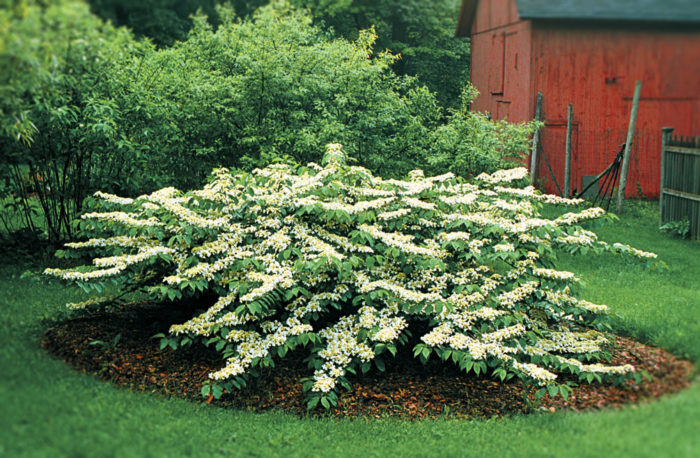
It can be risky for a nursery owner to go out on a limb about naming his favorite plants. But I have absolutely no qualms about saying that viburnums are my pick for the most versatile and garden-worthy genus of shrubs. Besides having attractive foliage and growth habits, the best viburnums also offer lovely—sometimes even fragrant—flowers. Many also boast colorful fruits and stunning fall foliage. In addition, the fruits are appealing to birds and other wildlife. What more could you ask of a shrub?
Learn more: A Step-by-Step Guide to Pruning Viburnums
As a garden designer, whenever I’ve needed a shrub for a problem area—dry, wet, sunny, or shady—a viburnum has always come to the rescue. There are more than 150 species of Viburnum; many are native to North America, growing in USDA Hardiness Zones 2 to 9. My current garden is in Zone 6, Connecticut, but I’ve also grown viburnums in the Zone 2 climate of Vermont.
Subscribe to Fine Gardening magazine to learn more about great plants like viburnums. In fact, you’ll find instruction and inspiration for gardeners of every skill level.
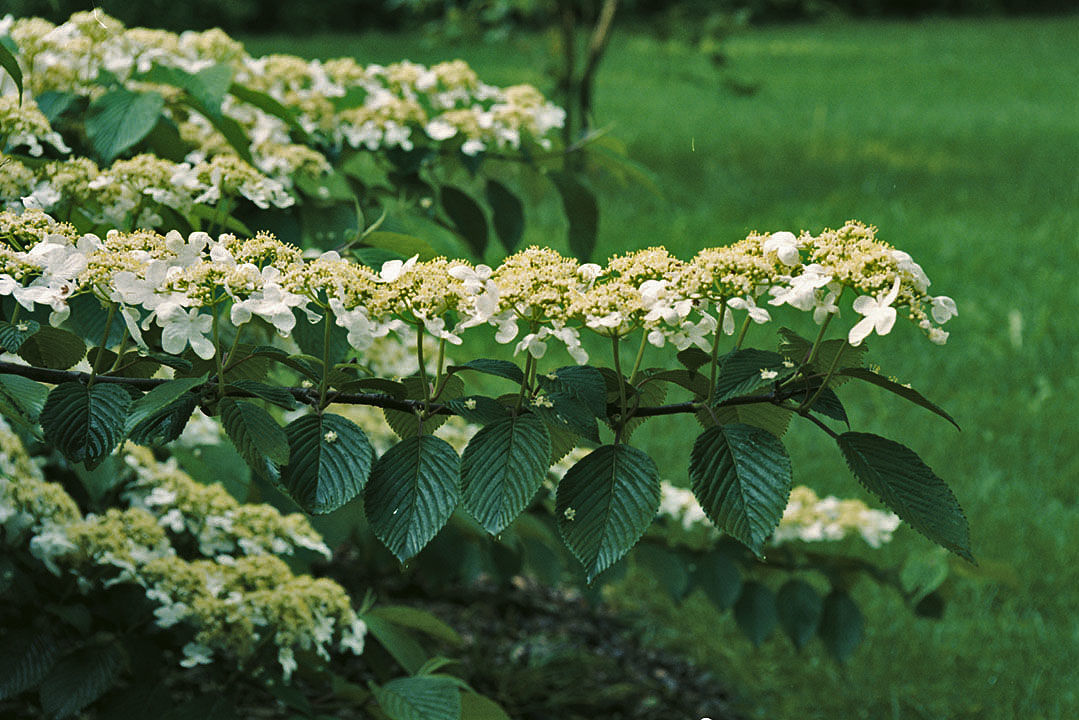
Viburnum spp. and cvs.
Vie-BUR-num
- A genus of more than 150 evergreen, semi-evergreen, and deciduous woody plants. Many are native to North America, but their range extends to Southeast Asia and South America. They are admired for their foliage, flowers, and fruit.
- Most viburnums flower in spring. The sometimes-fragrant flowers range from white and cream to pink-flushed or wholly pink. They are borne in terminal or axillary panicles, clusters, corymbs, or cymes, which are often spherical or domed. Some species have blooms similar to the flattened heads of lacecap hydrangeas.
- Many species bear ornamental fruits in late summer or fall. They are usually spherical or ovoid and may be red, yellow, blue, or black.
- Most viburnums grow in any moderately fertile, moist but well-drained soil in full sun to partial shade. Some viburnums prefer dry soil.
- Viburnums can be propagated by seed, but the process is labor-intensive. Instead, take softwood cuttings when a 6-inch terminal branch snaps when bent, which is usually in summer.
- Cold hardiness varies by species, but most viburnums will grow in USDA Hardiness Zones 4 to 8.
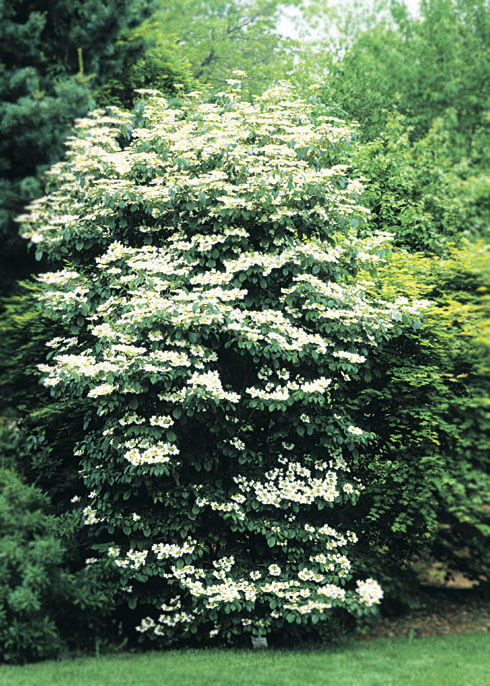
Viburnums are usually shrubs, but their habits vary. A few dwarf varieties, such as Viburnum opulus ‘Nanum’, are under 3 feet. Others, such as Seibold viburnum (V. seiboldii), may grow up to 20 feet tall. Most viburnums also have a full spreading habit. Some viburnums can become medium-size trees, especially if they are pruned. Viburnums excel as specimen plants or as anchors in mixed borders. You won’t find a more versatile group of shrubs for hedges or for massing in groups, since viburnums hold their own in every season. Some viburnums, such as Prague viburnum (V. ‘Pragense’), are evergreen. Others, such as leatherleaf viburnum (V. rhytidophyllum), are semi-evergreen in colder climates, losing their leaves when temperatures dip below 10° F.
A few viburnums can be grown as standards and used in various settings. A viburnum standard can create height in the back of a border or in pots on each side of a terrace entrance, underplanted with annuals. Varieties that look good as standards are: V. plicatum var. tomentosum ‘Newport’, V. carlesii ‘Compactum’, and V. × bodnantense ‘Dawn’. The latter’s late-winter blooms provide a wonderful display.
- Find the perfect viburnum in our plant guide.
- Watch a video about planting ornamentals grown in containers.
- When you’re pruning, it’s important to use sharp pruners and to know where to make your cuts.
These adaptable shrubs are easy to grow
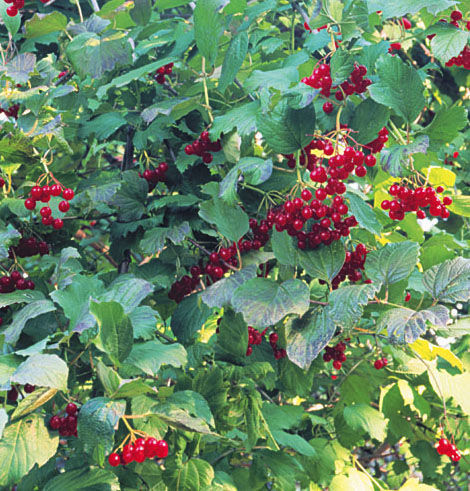
One of the things I like most about viburnums is that they grow without a lot of fussing over them. Those that are native to North America are especially adaptable. For example, although Southern blackhaw viburnum (V. rufidulum) grows as an understory shrub in the Piedmont, it will take full sun in good soil. This viburnum makes a fine specimen. Its rounded leaves turn burgundy in fall. Accented by blue drupes of fruit, it is breathtaking against a backdrop of evergreens. Another native, arrowwood viburnum (V. dentatum), adapts to many soil conditions. It weathered a recent drought here without looking the least bit straggly.
If you need a reliable shrub for deep shade with moist soil, consider hobblebush viburnum (V. alnifolium, also known as V. lantanoides). Hiking in New Hampshire recently, I came across the loveliest stand of hobblebush I’ve ever seen. Limbs that had fallen on the ground had taken root and formed a colony. Nannyberry viburnum (V. lentago) is another native that enjoys moist shade, but it can also adapt to sun and dry soil. It has creamy-white lacecap flowers in mid- to late May here in Connecticut. Its fruit—1/2-inch drupes—turns shades of yellow, rose, pink, and finally, bluish-black. Sometimes all shades are showing at once.
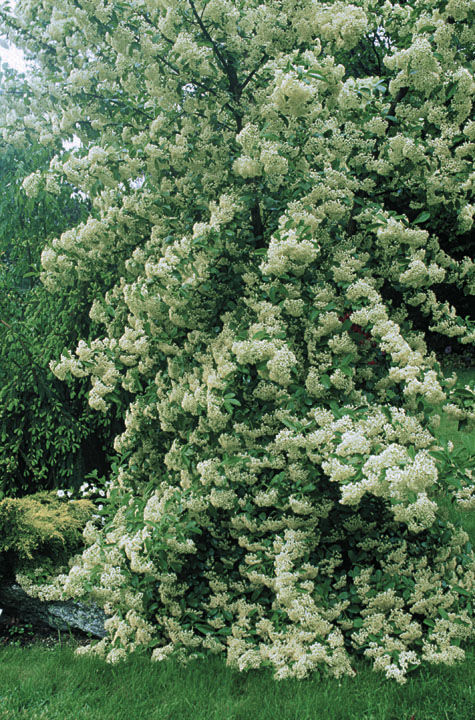
A close kin to these two natives is blackhaw viburnum (V. prunifolium). While it prefers dry feet, it’s adaptable to many soil types, and to sunny and shady sites. Its dark-green foliage turns purplish-red in fall, and its fruit turns from pink to bluish-black, with a waxy, gray bloom. I find it makes a great small, single-stem tree.
Most viburnums grow best in full sun but are just as content in light to partial shade. Except for a few varieties, noted in the chart Viburnums that excel from season to season, give them moderately fertile, moist but well-drained soil with a pH from 5.6 to 6.6. When viburnums enjoy good air circulation, they rarely suffer from fungal diseases. If they’re content in their site, they’re usually not bothered by pests.
Viburnums are known for their attractive foliage
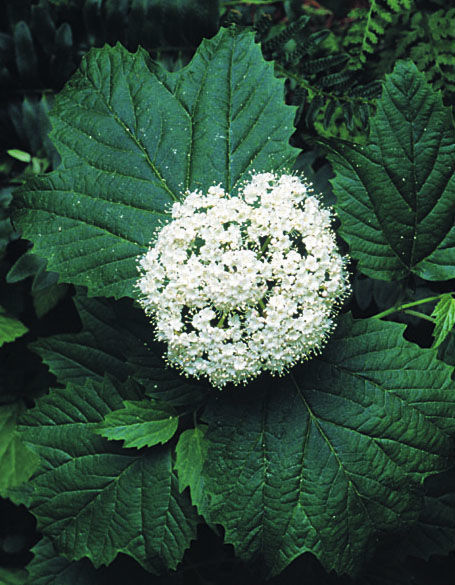
Most viburnums in cultivation have reliably attractive foliage. Leaves vary in size, texture, and color. Foliage may be rounded or lance-shape, and entire or toothed around the edges. Most deciduous viburnums have great fall color, ranging from yellow to red to burgundy, depending on the species or cultivar. But mapleleaf viburnum (V. acerfolium) is hard to beat, turning purple to rosy in the fall. This is also a shrub that could help you out in those dry, shady spots.
If you’re looking for an evergreen or semi-evergreen shrub, consider V. × rhytidophylloides and its cultivars. ‘Willowwood’ has lustrous, deeply veined green foliage and flowers in the fall. In my garden, it usually makes it through winter looking good. ‘Allegheny’ has dense, rounded, dark-green leaves. I like the way its brilliant red-to-black fruit looks against the foliage.
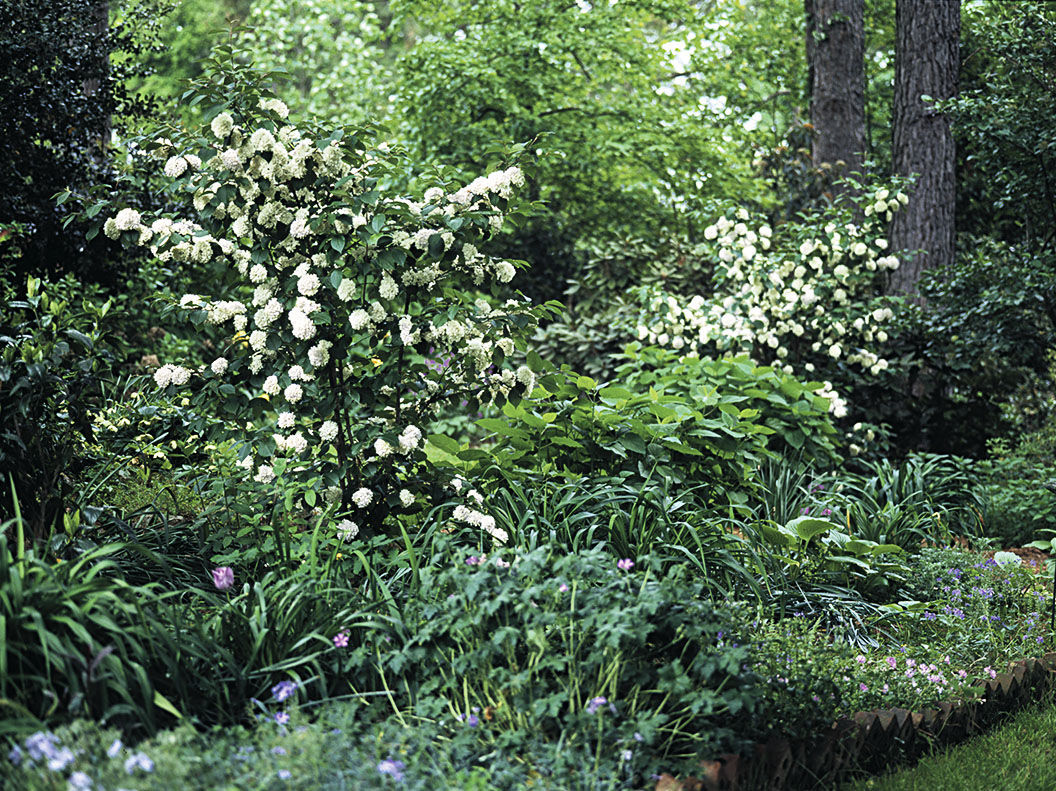
But don’t forget the flowers
Viburnums have two major types of flower heads: flat-topped clusters of flowers that resemble lacecap hydrangeas, and snowball types, with globe- or dome-shape flower clusters. Viburnum flowers range from creamy white to pink. The buds, often shaped like small nuts, are usually attractive as well.
The list of outstanding flowering viburnums is long, but I want to mention just a few. Burkwood viburnum (V. × burkwoodii), semi-evergreen in a mild winter, is extremely fragrant and has many cultivars. ‘Anne Russell’, a compact shrub, has fragrant pink buds and red fall foliage. ‘Mohawk’, introduced by the late Dr. Donald Egolf of the National Arboretum, has a striking fragrance of spice as its reddish buds open into white snowballs. Introduced by William Judd at the Arnold Arboretum in 1920, Judd viburnum (V. × juddii) is an extremely heavy flowering hybrid of V. bitchiuense. It has purple fall foliage with black fruit. Mayflower viburnum (V. carlesii), an old garden favorite, is popular for good reason. Also known as Korean spice viburnum, it has very fragrant pink buds that open to showy white snowball flowers. My favorite cultivars are ‘Cayuga’, a compact grower with pink buds, and ‘Compactum’, which grows to only 3 feet tall and wide in 10 years.
The straight species form of European cranberry bush (V. opulus) is not as exciting as some viburnums, but several cultivars are exceptional. ‘Xanthocarpum’, a white-flowering lacecap type, is one of my top-10 viburnums. It has dark-green foliage and yellowish stems with persistent yellow fruit. ‘Nanum’, a dwarf cultivar, grows to only 2 feet high and 3 feet wide in 10 years. It’s sometimes confused with ‘Compactum’, which gets much larger and flowers more than ‘Nanum’. European snowball viburnum (V. o. ‘Roseum’) is a sterile viburnum. Its showy and profuse snowball flowers start out apple-green and change to white.
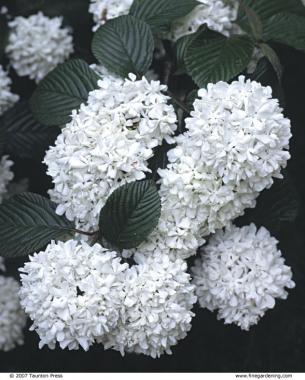
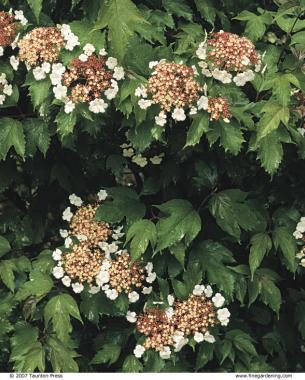
But the real floral show-stoppers are the doublefile viburnums (V. plicatum var. tomentosum). There are many fine cultivars in this group, though some of my favorites have little or no fragrance. They all have excellent orange-red foliage in autumn with red-black fruit. ‘Mariesii’ and ‘Shasta’ both have white lacecap flowers. ‘Kern’s Pink’ has pale-pink snowball flowers and dark-green leaves with magenta edges.
Last but not least is V. sargentii ‘Onondaga’, a knock-out cultivar introduced by Dr. Egolf. Its maroon foliage emerges at the same time as fertile flowers that are a little darker maroon and set off by sterile florets in white with a tint of burgundy. This sensational shrub makes a great specimen or hedge.
Colorful fruit adds appeal
Viburnums frequently set good-looking fruit, which often persists for a long time. Among the best fruiting viburnums is linden viburnum (V. dilatatum). Dr. Egolf also introduced some fine cultivars of this East Asian species. The red fruits of ‘Erie’ eventually turn coral, then pink. The compact-growing ‘Oneida’ holds its glossy, dark-red fruit for most of the winter. ‘Michael Dodge’, with its yellow fruit, is good for the autumn garden. The bright-red berries of tea viburnum (V. setigerum) often persist throughout winter. This Asian native will take a lot of shade, and you could try making tea from the leaves.
Smooth witherod (V. nudum), a fine native species, also puts on an exceptional show in fruit. Its berries turn from green to pink to red to dark blue. All these can appear on a single plant at the same time. ‘Winterthur’ is more compact. In fall, smooth witherod’s glossy leaves turn from tinted bronze to bright red.
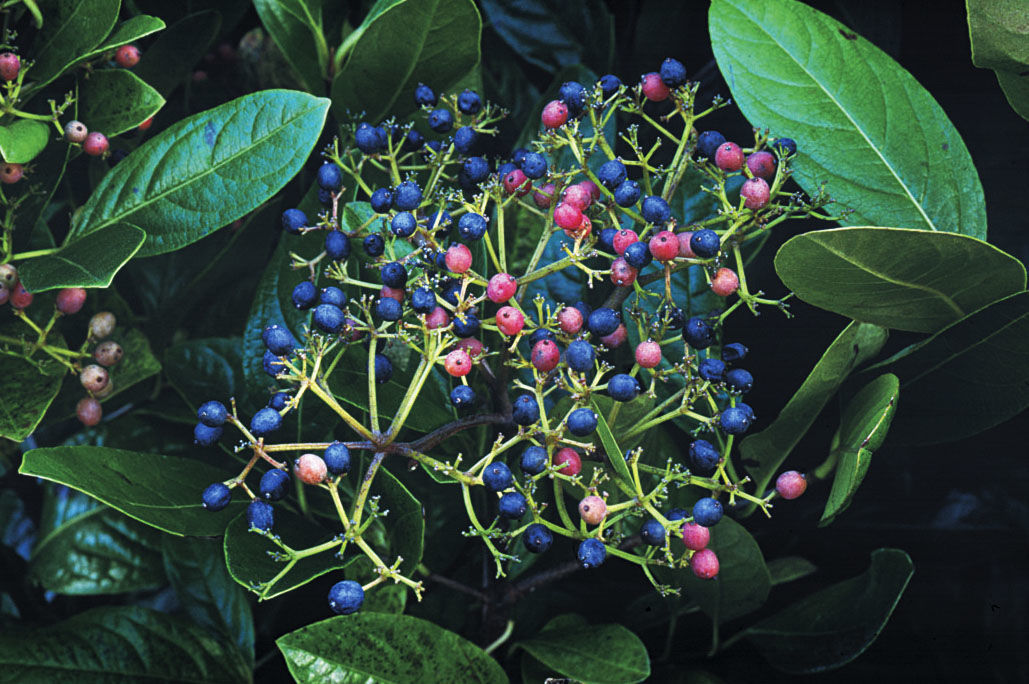
The native I probably use most often in planting schemes is American cranberry bush viburnum (V. trilobum), so named because its fruit looks like bright-red cranberries. Its crisp and shiny dark-green foliage turns reddish-purple in the fall. New growth emerges with a reddish tint. Compact cultivars, such as ‘Compactum Alfredo’, work well in hedges or shrub borders. ‘Wentworth’ is a must for winter interest, with its cherry-red winter fruit persisting well into January if the temperature doesn’t drop too drastically. American cranberry bush, however, does not like dry locations.
For good fruit displays, it’s important to remember that most viburnums are not self-pollinating. In fact, except for V. opulus, they are self-incompatible, which means they need a little genetic variability to fruit well. For example, witherod viburnum does not fruit well planted alone. When planted near its cousin, smooth witherod, its fruiting dramatically increases.
Once you plant a viburnum or three in your garden, you’re certain to enjoy them from season to season and for many years to come. And you’ll probably start looking for more of these rewarding shrubs to grow as well.
Viburnums that excel from season to season
I would be hard pressed to pick just a handful of exceptional viburnums, so this hefty chart lists a few dozen. Bloom times are for Zone 6. Semi-evergreen means that the shrub holds some or all of its leaves in a mild winter. Unless noted, viburnums grow well in moist, well-drained soil in full sun, but will also tolerate partial shade. North American native viburnums and their cultivars are indicated by an asterisk.
V. acerfolium* (mapleleaf viburnum)
Height and width: 4 to 6 feet by 3 to 4 feet. Flowers: yellowish-white lacecaps. Bloom time: May or June. Fruit: black; often persists into winter. Comments: good in dry shade; fall color ranges from creamy pink to deep purple. Zones: 3–8
V. alnifolium* (also known as V. lantanoides) (hobblebush)
Height and width: 7 to 8 feet by 8 to 10 feet. Flowers: white lacecaps; fragrant. Bloom time: May. Fruit: red to purple-black. Comments: excellent red-purple fall color; good understory plant for moist shade. Zones: 3–6
V. × bodnantense ‘Dawn’
Height and width: 8 to 10 feet by 6 feet. Flowers: pink buds open to white; fragrant. Bloom time: February–April. Fruit: red to black. Comments: foliage emerges bronzy-green, matures to dark green. Zones: 4–8
V. × burkwoodii (Burkwood viburnum)
Height and width: 8 feet by 5 feet. Flowers: pink buds open to white snowballs; spicy fragrance. Bloom time: March–April. Fruit: red to black. Comments: semi-evergreen. Zones: 4–8
V. × burkwoodii ‘Anne Russell’
Height and width: 6 feet by 8 feet. Flowers: pink buds open to white snowballs; fragrant. Bloom time: April. Fruit: red to black. Comments: semi-evergreen. Zones: 5–8
V. × burkwoodii ‘Mohawk’
Height and width: 7 feet by 5 feet. Flowers: dark red buds open to white snowballs; clove fragrance. Bloom time: May. Fruit: red to black. Comments: orange-red fall color; disease-resistant. Zones: 5–8
V. × carlcephalum (fragrant snowball viburnum)
Height and width: 6 to 10 feet by 6 to 10 feet. Flowers: pink opening to white snowballs; fragrant. Bloom time: May. Fruit: red to black. Comments: vigorous, upright-growing shrub. Zones: 5–8
V. carlesii (Mayflower viburnum, Korean spice viburnum)
Height and width: 10 to 12 feet by 7 to 8 feet. Flowers: pink buds open to white, very fragrant snowballs. Bloom time: May. Fruit: red to black. Comments: dense shrub with upright spreading branches. Zones: 4–7
V. carlesii ‘Compactum’
Height and width: 4 feet by 4 feet. Flowers: pink buds open white; very fragrant. Bloom time: May. Fruit: red to black. Comments: very dark green foliage turns wine-red in fall; excellent for borders. Zones: 4–7
V. cassinoides* (witherod viburnum)
Height and width: 6 to 10 feet by 5 to 6 feet. Flowers: creamy white lacecaps. Bloom time: June. Fruit: green to red to blue-black, often all at once. Comments: orange to purple fall color. Zones: 4–8
V. dentatum* (arrowwood viburnum)
Height and width: 10 to 12 feet by 5 to 6 feet. Flowers: creamy white, fragrant lacecaps. Bloom time: May–June. Fruit: yellow to glossy red to purple. Comments: adapts to varied soil conditions. Zones: 2–8
V. dilatatum (linden viburnum)
Height and width: 8 to 10 feet by 7 to 8 feet. Flowers: creamy white lacecaps, slightly fragrant. Bloom time: May–June. Fruit: red-scarlet, often persists into winter. Comments: bronze to russet fall color. Zones: 4–8
V. dilatatum ‘Erie’
Height and width: 10 feet by 6 feet. Flowers: creamy white lacecaps. Bloom time: May–June. Fruit: prolific and persistent. Comments: yellow to red fall color. Zones: 5–8
V. dilatatum ‘Michael Dodge’
Height and width: 8 to 10 feet by 5 to 7 feet. Flowers: creamy white lacecaps. Bloom time: May–June. Fruit: yellow; persistent. Comments: scarlet to burgundy fall color foliage. Zones: 5–8
V. dilatatum ‘Oneida’
Height and width: 5 feet by 5 feet. Flowers: white lacecaps. Bloom time: May. Fruit: red fruit; persistent. Comments: pale yellow to orange-red fall color. Zones: 5–8
V. × juddii (Judd viburnum)
Height and width: 7 feet by 6 feet. Flowers: white, very fragrant snowball type. Bloom time: April–May. Fruit: red to black. Comments: exceptional flowering shrub. Zones: 4–8
V. lantana ‘Mohican’ (wayfaring tree)
Height and width: 8 feet by 9 feet. Flowers: white snowballs, not fragrant. Bloom time: May. Fruit: orange to red to black. Comments: excellent foliage turns purple in fall; takes dry soil. Zones: 3–7
V. lentago* (nannyberry viburnum, sheepberry)
Height and width: 15 to 20 feet by 8 to 10 feet. Flowers: creamy-white lacecaps. Bloom time: May. Fruit: from green to blue-black; lasts into winter. Comments: fine small specimen tree; adapts to wet or dry soil. Zones: 2–8
V. nudum ”Winterthur’* (smooth witherod)
Height and width: 6 to 8 feet by 5 feet. Flowers: creamy-white lacecaps. Bloom time: June. Fruit: green to pink to red to blue, often at once. Comments: fine small specimen tree; red to reddish-purple fall color. Zones: 5–9
V. opulus ‘Xanthocarpum’ (yellow-fruited European cranberry bush)
Height and width: 6 feet by 6 feet. Flowers: white lacecaps. Bloom time: May. Fruit: yellow fruit; persistent. Comments: excellent compact form; lime-green foliage turns yellow in fall. Zones: 3–7
V. opulus ‘Nanum’ (dwarf European cranberry bush)
Height and width: 2 feet by 3 feet. Flowers: white snowballs. Bloom time: May. Fruit: rarely produces fruit. Comments: excellent fall color; good for small hedge; does not tolerate wet soil. Zones: 3–7
V. opulus ‘Roseum’ (European snowball bush)
Height and width: 8 to 10 feet by 6 to 7 feet. Flowers: white snowballs. Bloom time: May. Fruit: red to black. Comments: great color for shrub border. Zones: 3–7
V. plicatum var. tomentosum ‘Kern’s Pink’ (pink doublefile viburnum)
Height and width: 6 feet by 8 feet. Flowers: light pink snowballs. Bloom time: May. Fruit: red to black. Comments: dark green foliage with magenta leaf margins. Zones: 3–8
V. plicatum var. tomentosum ‘Mariesii’ (doublefile viburnum)
Height and width: 8 feet by 12 feet. Flowers: white lacecaps. Bloom time: May. Fruit: red to black. Comments: elegant horizontal branching; reddish-purple fall color. Zones: 5–8
V. plicatum var. tomentosum ‘Shasta’ (doublefile viburnum)
Height and width: 6 feet by 5 feet. Flowers: large white lacecaps. Bloom time: May. Fruit: red to black. Comments: plum-hued fall color; great as a specimen. Zones: 5–8
V. plicatum var. tomentosum ‘Summer Snowflake’ (doublefile viburnum)
Height and width: 10 feet by 5 feet. Flowers: white lacecaps. Bloom time: June–September. Fruit: red to black. Comments: great for all-summer blooms; yellow-orange fall color. Zones: 3–8
V. plicatum var. tomentosum ‘Newport’ (doublefile viburnum)
Height and width: 5 feet by 5 feet. Flowers: white snowballs; light fragrance. Bloom time: May. Fruit: rarely produces fruit. Comments: dark green leaves turn burgundy in fall. Zones: 5–8
V. prunifolium* (blackhaw viburnum)
Height and width: 12 to 15 feet by 8 to 12 feet. Flowers: creamy white lacecaps. Bloom time: May. Fruit: pink to bluish-black. Comments: purple-red fall foliage; lovely native tree, mildew-resistant. Zones: 3–9
V. × rhytidophylloides ‘Allegheny’*
Height and width: 10 feet by 12 feet. Flowers: creamy white lacecaps. Bloom time: May (may continue blooming). Fruit: red to black. Comments: semi-evergreen. Zones: 4–8
V. × rhytidophylloides ‘Willowwood’*
Height and width: 12 feet by 12 feet. Flowers: creamy white, dome-shaped. Bloom time: May (may continue blooming). Fruit: red to black. Comments: semi-evergreen, pleasing arching habit. Zones: 4–8
V. rufidulum* (Southern blackhaw viburnum)
Height and width: 15 feet by 8 feet. Flowers: white lacecaps. Bloom time: May. Fruit: dark blue. Comments: burgundy fall foliage. Zones: 5–9
V. sargentii ‘Onondaga’ (‘Onondaga’ Sargent viburnum)
Height and width: 12 feet by 6 feet. Flowers: maroon lacecap flowers with white florets. Bloom time: May. Fruit: scarlet. Comments: new foliage is maroon; must have moist soil. Zones: 3–7
V. setigerum (tea viburnum)
Height and width: 10 to 12 feet by 8 to 10 feet. Flowers: white lacecaps. Bloom time: May–June. Fruit: red-orange in pendant clusters; persistent. Comments: excellent woodland shrub. Zones: 5–7
V. sieboldii (Seibold viburnum)
Height and width: 15 to 20 feet by 10 to 15 feet. Flowers: profuse, creamy white lacecaps. Bloom time: May. Fruit: apricot to red, heavy clusters; persistent. Comments: large shrub or small tree, green-purple fall foliage, deer resistant. Zones: 4–8
V. trilobum* (American cranberry bush)
Height and width: 8 to 12 feet by 8 to 12 feet. Flowers: white lacecaps. Bloom time: May. Fruit: red; edible. Comments: yellow to burgundy fall foliage; makes nice hedge. Zones: 2–7
V. trilobum ‘Compactum’ (compact American cranberry bush)
Height and width: 4 feet by 3 feet. Flowers: white lacecaps. Bloom time: May. Fruit: yellow to red; persistent. Comments: orange to burgundy fall foliage; good for mixed shrub border. Zones: 2–7
V. trilobum ‘Wentworth’ (Wentworth cranberry bush)
Height and width: 8 feet by 6 feet. Flowers: white lacecaps. Bloom time: May. Fruit: yellow to bright red; persistent. Comments: red fall color; excellent for winter garden. Zones: 2–7
Fine Gardening Recommended Products

Pruning Simplified: A Step-by-Step Guide to 50 Popular Trees and Shrubs
Fine Gardening receives a commission for items purchased through links on this site, including Amazon Associates and other affiliate advertising programs.

Spear & Jackson 4930FZ Razorsharp Telescopic Tree Pruner
Fine Gardening receives a commission for items purchased through links on this site, including Amazon Associates and other affiliate advertising programs.

ARS Telescoping Long Reach Pruner
Fine Gardening receives a commission for items purchased through links on this site, including Amazon Associates and other affiliate advertising programs.

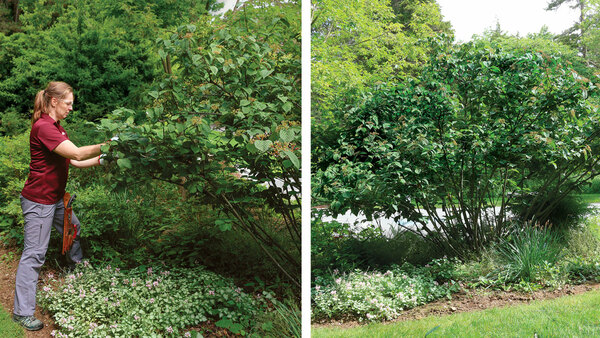
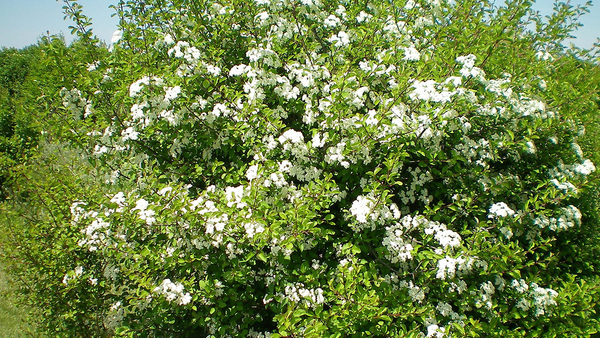
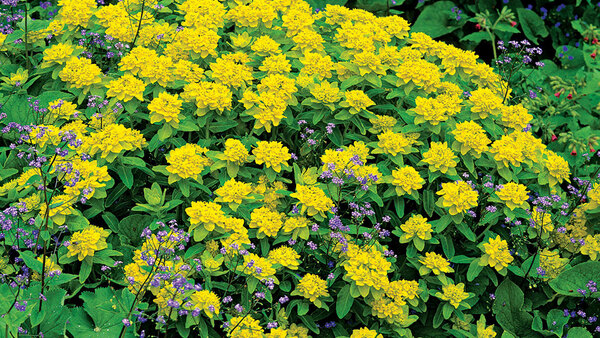
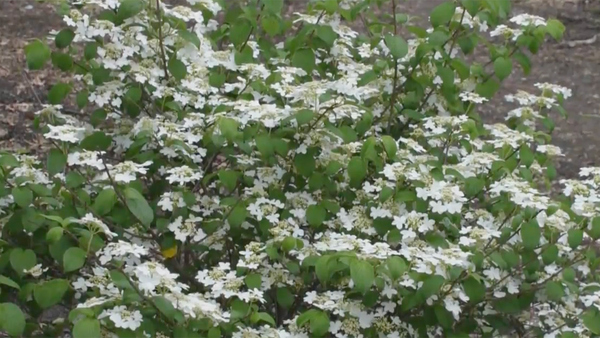













Comments
My 'leather leaf' viburnum's leaves turn yellow every spring and drop. The whole time the rest of the shrub is growing and flowering. After the leaves drop the rest of the season it looks fine. Is this normal? Is there something I can do? It looks terrible this time of year.
Give them some nutrients. Iron, sulphur, magnesium to avoid the yellow drop.
Hello. I live in Washington DC and have a Korean Spice Viburnum that doesn't produce the delicious flowers I've heard about. Any ideas on encouraging blooms? Thank you.
Are the berries on the viburnum trilobum edible or poisonous ?
can I grow a viburnum in a container pot? mine is in one and the new top shoots are drooping!!!
i live in hardiness zone 7a. can i grow viburnum as a winter plant? when is the time to plant it?
We have a north facing home with a red oak in the front yard, providing almost full shade to the front bed during most of the year. North Texas area. I have some hollies that are not doing well that I would like to replace. Soil is clay. Winters seldom go below 20 degrees. Summer is routinely between 97 and 105. Drought is common, but I do have sprinklers. Will one of the dwarf varieties of virbernum work? Newport, Nanum, or Koreanspice? Any of those native to the US? Will they be evergreen in the North Dallas area?
Log in or create an account to post a comment.
Sign up Log in